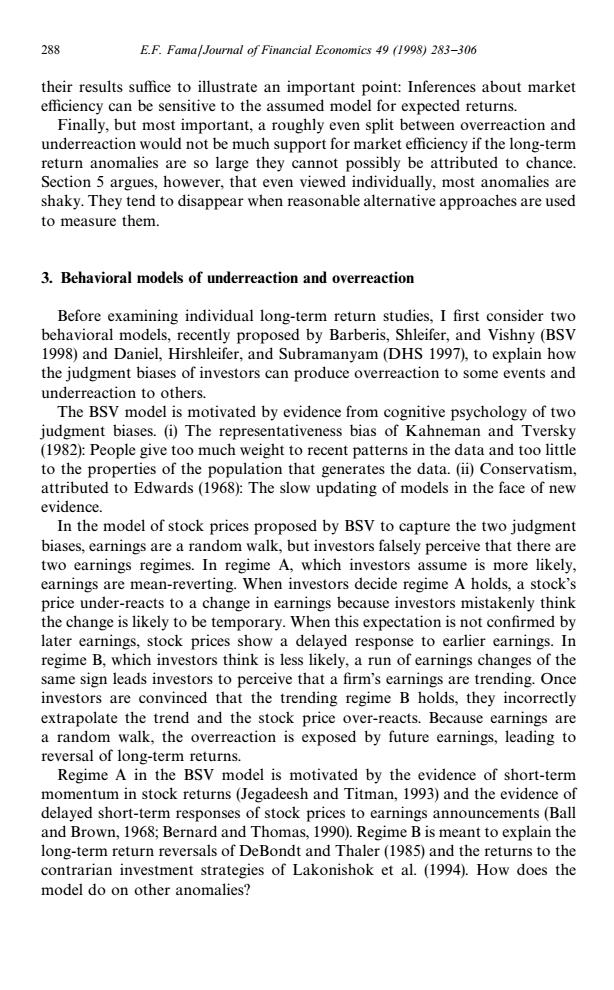正在加载图片...

288 E.F.FamafJournal of Financial Economics 49 (1998)283-306 their results suffice to illustrate an important point:Inferences about market efficiency can be sensitive to the assumed model for expected returns. Finally,but most important,a roughly even split between overreaction and underreaction would not be much support for market efficiency if the long-term return anomalies are so large they cannot possibly be attributed to chance. Section 5 argues,however,that even viewed individually,most anomalies are shaky.They tend to disappear when reasonable alternative approaches are used to measure them. 3.Behavioral models of underreaction and overreaction Before examining individual long-term return studies,I first consider two behavioral models,recently proposed by Barberis,Shleifer,and Vishny(BSV 1998)and Daniel,Hirshleifer,and Subramanyam(DHS 1997),to explain how the judgment biases of investors can produce overreaction to some events and underreaction to others. The BSV model is motivated by evidence from cognitive psychology of two judgment biases.(i)The representativeness bias of Kahneman and Tversky (1982):People give too much weight to recent patterns in the data and too little to the properties of the population that generates the data.(ii)Conservatism, attributed to Edwards(1968):The slow updating of models in the face of new evidence. In the model of stock prices proposed by BSV to capture the two judgment biases,earnings are a random walk,but investors falsely perceive that there are two earnings regimes.In regime A,which investors assume is more likely, earnings are mean-reverting.When investors decide regime A holds,a stock's price under-reacts to a change in earnings because investors mistakenly think the change is likely to be temporary.When this expectation is not confirmed by later earnings,stock prices show a delayed response to earlier earnings.In regime B,which investors think is less likely,a run of earnings changes of the same sign leads investors to perceive that a firm's earnings are trending.Once investors are convinced that the trending regime B holds,they incorrectly extrapolate the trend and the stock price over-reacts.Because earnings are a random walk,the overreaction is exposed by future earnings,leading to reversal of long-term returns. Regime A in the BSV model is motivated by the evidence of short-term momentum in stock returns (Jegadeesh and Titman,1993)and the evidence of delayed short-term responses of stock prices to earnings announcements(Ball and Brown,1968;Bernard and Thomas,1990).Regime B is meant to explain the long-term return reversals of DeBondt and Thaler(1985)and the returns to the contrarian investment strategies of Lakonishok et al.(1994).How does the model do on other anomalies?their results suffice to illustrate an important point: Inferences about market efficiency can be sensitive to the assumed model for expected returns. Finally, but most important, a roughly even split between overreaction and underreaction would not be much support for market efficiency if the long-term return anomalies are so large they cannot possibly be attributed to chance. Section 5 argues, however, that even viewed individually, most anomalies are shaky. They tend to disappear when reasonable alternative approaches are used to measure them. 3. Behavioral models of underreaction and overreaction Before examining individual long-term return studies, I first consider two behavioral models, recently proposed by Barberis, Shleifer, and Vishny (BSV 1998) and Daniel, Hirshleifer, and Subramanyam (DHS 1997), to explain how the judgment biases of investors can produce overreaction to some events and underreaction to others. The BSV model is motivated by evidence from cognitive psychology of two judgment biases. (i) The representativeness bias of Kahneman and Tversky (1982): People give too much weight to recent patterns in the data and too little to the properties of the population that generates the data. (ii) Conservatism, attributed to Edwards (1968): The slow updating of models in the face of new evidence. In the model of stock prices proposed by BSV to capture the two judgment biases, earnings are a random walk, but investors falsely perceive that there are two earnings regimes. In regime A, which investors assume is more likely, earnings are mean-reverting. When investors decide regime A holds, a stock’s price under-reacts to a change in earnings because investors mistakenly think the change is likely to be temporary. When this expectation is not confirmed by later earnings, stock prices show a delayed response to earlier earnings. In regime B, which investors think is less likely, a run of earnings changes of the same sign leads investors to perceive that a firm’s earnings are trending. Once investors are convinced that the trending regime B holds, they incorrectly extrapolate the trend and the stock price over-reacts. Because earnings are a random walk, the overreaction is exposed by future earnings, leading to reversal of long-term returns. Regime A in the BSV model is motivated by the evidence of short-term momentum in stock returns (Jegadeesh and Titman, 1993) and the evidence of delayed short-term responses of stock prices to earnings announcements (Ball and Brown, 1968; Bernard and Thomas, 1990). Regime B is meant to explain the long-term return reversals of DeBondt and Thaler (1985) and the returns to the contrarian investment strategies of Lakonishok et al. (1994). How does the model do on other anomalies? 288 E.F. Fama/Journal of Financial Economics 49 (1998) 283—306